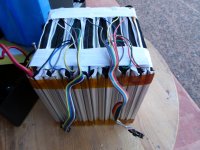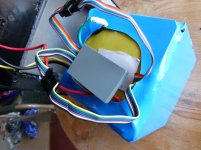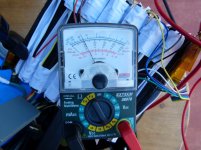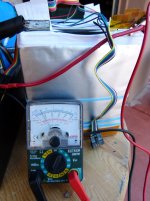you can find the cell phone chargers at the goodwill or geek shops used for cheap. i dig them outa the dumpsters so i have a pile.
you will need a voltmeter if you don't have one already. to verify the polarity of the wires from the cell phone charger. they call them 'adapters' too.
buy some alligator clips and solder them on to the ends of the wire coming from the charger. it will usually be a pair of wires, tiny and running together or it can be one wire inside of a sleeve braided around the central core. the braided part is almost always, i would say always, the ground or negative. undo the braid enuff to make sure the two wires are separated a lot so you have enuff wire to use. you need to be able to attach the alligator clips some distance from each other so you need enuff slack.
harbor freight sells the alligator clips and you can buy short jumper wires with alligator clips on the ends too for doing stuff like this. look at what they have, but you need the alligator clips on the ends of the wires so you can clip the wires from the charger directly to the terminals of the cell. harbor freight sells the cheap voltmeters too, i just bot 3 more for $2.99 each to replace some of those i have blown up recently.
you don't have to disconnect the cell from the others, just put the positive lead of the charger on the positive terminal of the cell and the negative lead of the charger on the negative electrode terminal. this is why you have to use alligator clips.
the best way to measure the charging current is to use the ammeter function on the DVM, digital voltmeter, and by allowing the charging current to flow through the ammeter, you can measure how much current is flowing into the cell as you charge it up.
this is a 15Ah cell so you would wanna use the 10A scale and plug the black voltmeter lead into the spot that says 10A, not the regular spot that says ground or negative, the black one. the normal ammeter range is too small for the current from the charger so you need to use the 10A scale (look at your meter and it will be more clear).
the charger will push about 500mA or 1/2A. so it will take 30 hours at 500mA to charge up the 15Ah cell to 3.65V. if you don't see the voltage climb up to that level in the 30 hours time it takes to push the 15Ah then there is definitely something wrong with the cell. if it fails to charge up to 3.65V in that time you can assume it has real problems, but until you charge it there is no way to know anything.
CAUTION! you need to remember that if you use the same voltmeter to measure the current, and then wanna use the same one to measure the voltage, you have to unplug the black lead from the 10A spot and put it in the regular spot and reset the scale to DC volts. this is really important to remember because this is how voltmeters die, it happens all the time and since you are new, you have to be double careful to not test for voltage while it is set up to measure current. remember to double check. i have 5 dead voltmeters on my table now so i know it happens. which is why i emphasize it.
but you can use the ammeter scale to see how much current is flowing and it should remain flat for the entire time so you don't have to leave it in the circuit all the time, just until you have good current value. write it down and use it to estimate how long you need to charge because you don't wanna charge too long and allow the voltage to climb over 4V. this is critical. over 4V is really bad for lifepo4. watch the voltage like a hawk when it climbs up to 3.5-3.6V because it goes up fast above that level.
so find a cell phone charger, tease the wires apart, solder on some alligator clips, start charging through the ammeter, keep track of the time, and then keep measuring the voltage as you get closer to full charge and stop it when it get to 3.65V or just a little bit above. when you can get to that point, then just disconnect everything and measure the voltage on the cell to see where the voltage finally drops to over time up to several days.
if it stays close to 3.4-3.5V that would be great. if it drops below 3.3V then it is not good but we can still measure the capacity of the cell to see how functional it still is. we can explain how to do that later once you figure out how to charge up this one cell.
this is actually something that everyone has to do at one time or another so it would be good for you to have this kinda stuff or tools available all the time to use if you wanna maintain your electric scooter.








